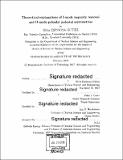Theoretical explanations of I-mode impurity removal and H-mode poloidal pedestal asymmetries
Author(s)
Espinosa Gútiez, Silvia
DownloadFull printable version (44.99Mb)
Other Contributors
Massachusetts Institute of Technology. Department of Nuclear Science and Engineering.
Advisor
Peter J. Catto.
Terms of use
Metadata
Show full item recordAbstract
Using high-z wall materials switches the fusion challenge from heat load handling to removing impurities. I propose the first method of measuring the radial impurity flux from currently available diagnostics. It provides a means of solving the impurity accumulation problem while providing free fueling for optimum tokamak performance. High confinement mode operation was discovered 35 years ago to almost quadruple fusion power, and later explained by turbulence reduction by sheared flows. Less than a decade ago, improved mode operation was discovered to have the same desirable property, while removing impurities and providing fueling. Thanks to the impurity radial particle flux measuring technique developed, I explain the outward radial impurity flux without invoking a (sometimes undetected) turbulent mode. This theory is supported by the observed E x B flow shear, which also explains the desired energy confinement via turbulence reduction. Stronger impurity density in-out poloidal asymmetries than predicted by the most comprehensive neoclassical models have been measured in several tokamaks around the world during the last decade, calling into question the reduction of turbulence by sheared radial electric fields in H-mode tokamak pedestals. However, these pioneering theories neglect the impurity diamagnetic drift, or fail to retain it self-consistently as proven in this thesis, while recent measurements indicate that it can be of the same order as the ExB drift. I have developed the first self-consistent theoretical model retaining the impurity diamagnetic flow and the two-dimensional features it implies due to its associated non-negligible radial flow divergence. It successfully explains collisionally the experimental impurity density, temperature and radial electric field in-out asymmetries; thus making them consistent with H-mode pedestal turbulence reduction.
Description
Thesis: Sc. D., Massachusetts Institute of Technology, Department of Nuclear Science and Engineering, 2018. Cataloged from PDF version of thesis. "February 2018." Includes bibliographical references (pages 203-214).
Date issued
2018Department
Massachusetts Institute of Technology. Department of Nuclear Science and EngineeringPublisher
Massachusetts Institute of Technology
Keywords
Nuclear Science and Engineering.